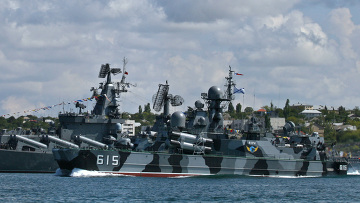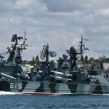
Russian Black Sea Fleet Strengthens Presence in Ukraine
Publication: Eurasia Daily Monitor Volume: 8 Issue: 15
By:

The Russian Navy plans to increase its presence on Ukrainian territory by adding urban infrastructure and civilian manpower to its naval assets in Sevastopol. The command of Russia’s Black Sea Fleet intends to build a housing estate (“mikrorayon”) for 20,000 personnel of the fleet, their dependents, and civilian service providers to the Russian fleet in that city. The housing estate and associated service infrastructure is planned to occupy both sides of Kazachya Bay, alongside the base of a Russian “marine infantry” (amphibious landing troops) regiment.
The government of Russia will finance this program from a fund dedicated to the socio-economic development of Sevastopol. That fund currently stems from the 2010 arrangements to subsidize Ukraine’s consumption of Russian gas. The socio-economic fund’s value is deducted from the value of that subsidy. This portion, consequently, helps to consolidate Russia’s military foothold on Ukrainian territory. The head of the Sevastopol city administration (by law a Ukrainian government appointee), Valery Saratov, has expressed gratitude in announcing this Russian building program (Interfax-Ukraine, January 16).
On April 21, 2010, Presidents Viktor Yanukovych and Dmitry Medvedev signed the agreement to prolong the Russian Fleet’s basing rights in Ukraine beyond the 2017 expiration date, by another 25 years, with a further five-year extension option to 2047. In return, Russia agreed to grant a 30 percent discount on the price of Russian natural gas to Ukraine, if that price exceeds $336 per one thousand cubic meters (tcm).
It now turns out, however, that an implementation mechanism and even a common understanding of that arrangement are lacking. On April 18, 2010 in Moscow, the Russian and Ukrainian Finance Ministers, Aleksei Kudrin and Fedir Yaroshenko, respectively, started negotiations on implementing the April 21, 2010 agreements. The Russian side seems more interested in quibbling and stalling, than in delivering. Kudrin insisted that “a new agreement” must be negotiated to define “concrete terms and parameters, on which implementation would depend.” For his part, Yaroshenko seemed to plead for overcoming a deadlock: “For us it is important to reach a common interpretation, define a common methodology for implementing this agreement in real life” (Interfax-Ukraine, January 18).
While Kyiv sounds anxious about Moscow delivering “in real life,” Moscow may well turn its side of the bargain into a dead letter. The price of gas seems unlikely to stay above $300 per tcm (unless Moscow decides to practice overt extortion and by the same token subsidize its own extortion of Ukraine). Below that price level, Russia can still pressure Ukraine into further concessions, in return for further discounts on the gas price. This would probably be that “new agreement” to which Kudrin is alluding.
Moscow is well placed to implement the naval base extension agreement while bargaining over implementation of the gas price agreement. The April 2010 arrangements are asymmetrical in that the naval base agreement is self-enforcing while the gas agreement is not. Ukraine lacks the power to withhold implementation or the former, while Russia has ample means to set conditions for implementing the latter.
Since those agreements were signed, Moscow has announced plans to replace old warships of its Black Sea Fleet with new ones, increase that Fleet’s tonnage in net terms, and upgrade the fleet’s weaponry. Modernization plans as announced during 2010 envisage adding one cruiser, several frigates, and several submarines by 2015. In addition, one Mistral-class amphibious attack ship (out of four planned for procurement from France) is supposed to be allocated to Russia’s Black Sea Fleet.
Russia’s naval presence in Ukraine underscores the Ukrainian government’s lax interpretation of the country’s non-bloc status. Ukraine’s current authorities have legislated for this status, and drastically curtailed cooperation with NATO, without developing a clear definition of the non-bloc status, or an international legal-political framework to ensure its observance. Within this grey area, Russia suggests that it would consider modernizing and operating itself the Ukrainian radars in Sevastopol and Mukacheve, as contribution to a common anti-missile defense system (Hryhory Perepelitsya, “Ukraine’s Non-Bloc Status Evolution,” Diplomatic Academy of Ukraine International Weekly, December 28, 2010).
Russia’s entrenchment in the Crimea has caught NATO, the United States, and the European Union distracted and wrong-footed. Some other actors now seek to develop a soft-security answer. On January 20 in Strasbourg, the European Parliament’s Foreign Affairs Committee adopted a resolution on the full range of security challenges in the Black Sea region. Inspired by Romanian MEP’s, and intended for submission to the European Parliament’s plenum, the resolution expresses particular concern about the extension of the Russian Black Sea Fleet’s lease on Ukrainian territory. The resolution suggests that the EU should develop a conflict-prevention and early-warning system. This would serve to build confidence throughout the region and help prevent threat of force, its use or escalation. Such a system would focus on arms transfers and naval activities. The proposal regards Russia as a desirable partner in such a system, alongside the EU and the Black Sea region’s countries (members or non-members of the EU). This area today faces key challenges that the EU cannot ignore (European Parliament press release, January 20).




